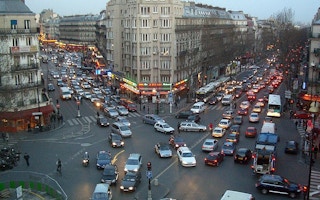Mayors around the world have led the way in bold climate action and have proven that there is a lot of opportunity in cities to tackle the global climate change problem.
To continue reading, subscribe to Eco‑Business.
There's something for everyone. We offer a range of subscription plans.
- Access our stories and receive our Insights Weekly newsletter with the free EB Member plan.
- Unlock unlimited access to our content and archive with EB Circle.
- Publish your content with EB Premium.
From car emissions tracking to doubling down on city commitments to the Paris Accord goals despite a lack of national government support, here are the top cities stories of 2017.
1. Paris, London commit to a new global scoring system for cars to tackle air pollution
Anne Hidalgo, chairperson of C40 Climate Leadership Group—a network of 91 of the world’s major cities committed to addressing climate change—led a call in March for vehicle manufacturers to stop producing cars that release dangerous levels of emissions.
As a measure to achieve this, the Paris mayor urged cities to implement a system to track how much emission cars give off on the road and how much impact they have on air quality. The results are published on a website showing how much pollution each car model emits, so car buyers can choose better vehicles.
Paris and London have already committed to make their data available online by the end-2017, while Madrid, Mexico City, Milan, Moscow and Oslo have agreed to work with C40 to develop this global scoring system.
2. US local mayors reiterate commitment to climate change
US cities continued to lead the fight against climate change, despite US President Donald Trump announcing the country’s withdrawal from the Paris Agreement this year.
More than 200 US cities in June protested the repeal the Clean Power Plan, which aims to reduce greenhouse gas emissions from power plants through new rules and standards.
New York City Mayor Bill de Blasio signed an executive order in June to reduce the city’s greenhouse gas emissions by 80 per cent by 2050, among other targets. In Pittsburgh, mayor Bill Peduto similarly issued an executive order that would continue working on 2030 climate objectives, including shifting to 100 per cent renewable energy
3. Tackling air pollution
Air pollution climbed to 12 times the normal levels in New Delhi in November, one of the worst levels recorded since 1999. The Indian Medical Association declared the situation a public health emergency, as people were asked not to leave their homes, flights were grounded and rail traffic delayed due to poor visibility.
At the height of the crisis, the government scrambled for quick fixes such as allowing cars with odd and even number plates to travel on alternate days to reduce the number of vehicles on the roads, and banning construction and industrial activities, but a long-term emergency response plan was not set in place.
Indonesia, for its part, implemented in September the Resilient Jakarta Secretariat as a step to solve Jakarta’s infamous congestion, which was once called the world’s worst traffic. The secretariat plans to analyse what the city’s issues are based on feedback from its government officials, researchers, and businesses and citizens’ groups.
The move comes after the capital joined 100 Resilient Cities, a network backed by The Rockefeller Foundation to help cities deal with 21st century threats such as earthquakes, fires, floods, inefficient public transportation system and food and water shortages.
4. More funding for cities against climate change
The World Bank this month committed US$4.5 billion to help cities in developing countries cover the costs of keeping their infrastructure and communities safe from climate disasters.
Meanwhile, the Asian Development Bank (ADB) announced in October a new loan in support of the Philippine administration’s plan to ramp up infrastructure development, especially in its cities. The loan will go directly to the Department of Transportation and the Department of Public Works and Highways, which is preparing flagship infrastructure projects worth between US$160 billion and US$180 billion over the next six years to help the Philippines, one of the countries most vulnerable to the effects of climate change, prepare for the future.
5. Sydney adopts plan to ensure net zero emissions by 2050
Sydney adopted in March an action plan to achieve net zero emissions by 2050. As a first step, it aims to reduce greenhouse gas emissions by 70 per cent and use renewable energy for half of its electricity needs by 2030.
The Environmental Action Plan 2016-2021 (EAP) was adopted by the City of Sydney council to step up its strategy to achieving zero waste, launch a decentralised water system, and put up its first net-zero emissions building.
Meanwhile Brisbane declared its city council to have achieved 100 per cent carbon neutrality in February through a combination of internal energy efficiency and emissions reduction projects, and renewable energy and carbon offset purchases. This milestone was met despite having an operating landfill and a large public transport fleet, making it the only organisation in Australia having done so this to date.
This story is part of our Year in Review series, which looks at the top stories that shaped the business and sustainability scene over the last 12 months.














